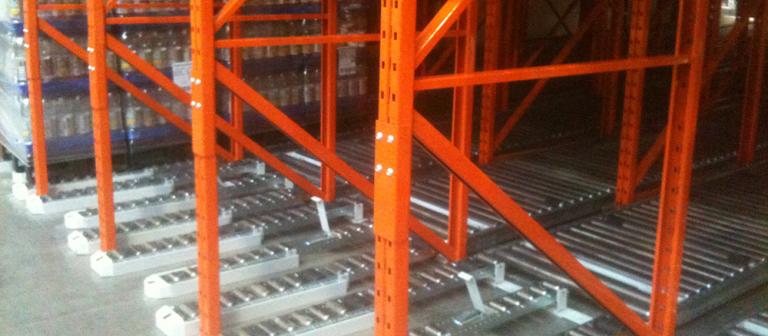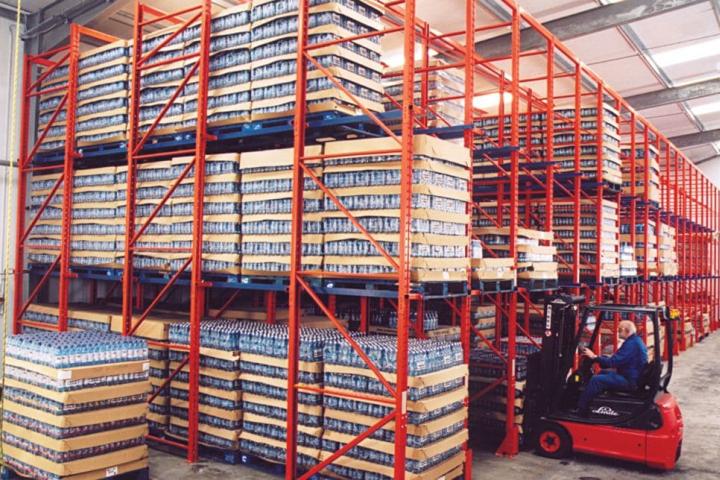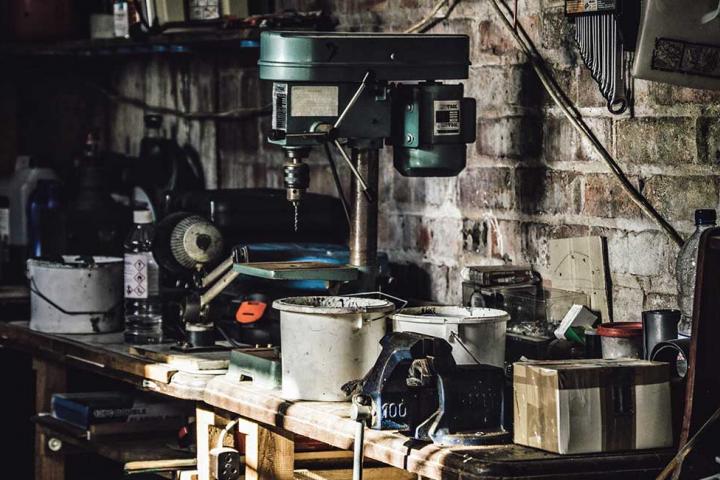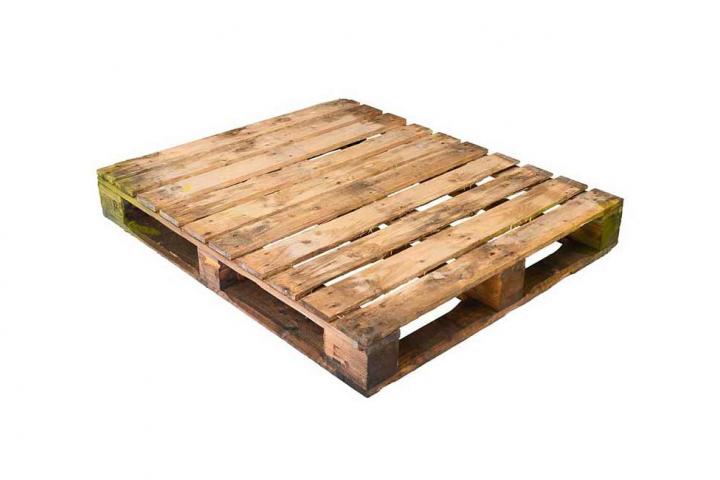Sacrificial legs can be quickly replaced at a low cost.
Wherever there are forklift trucks operating within an enclosed area, accidental damage is likely to occur particularly to the pallet racking. The front upright is the most exposed element which normally comes into contact with the forklift truck. Any racking inspection will be able to identify the severity of the damage and this could mean replacement parts are required. There is however a specialist piece of equipment designed to minimise the cost associated with frame damage. The sacrificial leg is a great way to repair this type of damage with a relatively low cost or interruption to the warehouse operation. One of the first available on the market was produced by Redirack in 1988. It was designed and developed following rigorous testing at the University of Sheffield before it went into production.
How a sacrificial leg is assembled.
Redirack were one of the first to produce a sacrificial leg but were soon followed by the likes of Dexion and PSS. Rediracks sacrificial leg was conceived due to Rediracks welded frame construction. When a welded frame gets damaged the whole frame would need replacing. Because the diagonal bracing is welded to both the front and back uprights it means that even when damage occurs to a length of bracing it can often require a complete frame replacement. The idea with a sacrificial leg is to make the lower front portion of a frame replaceable. In simple terms, on a sacrificial leg frame, the bottom part of the front upright is fabricated as a separate section and bolted in place. This section is approximately 1m in length and is bolted in place using an external splice channel. Rediracks sacrificial leg is only designed to be used with the Redirack system as is the case with other manufacturers who design their own.

Different manufacturers have different techniques.
The Dexion P90 Sacrificial Leg is designed to offer the same benefits but with a different configuration. While still offering a replacement section the option uses a load-bearing structural post that is bolted to the main upright but which is also anchored to the floor. The main upright starts at about 650mm from the floor and envelops the top part of the structural post almost like a sleeve. To add extra protection a sacrificial cover is fastened in place to the front of the post and is more cosmetic than protection. The cover is non-load bearing so can easily be replaced after any damage has occurred but without having to unload the racking.
If a frame does get damaged around its lower section there are a few options to remedy it. There is the preventative option which requires column protectors fixing in place as a physical barrier, this will help stop damage in the first place. There is the option of replacing the whole frame, the sub-frame if one is present, or just the damaged upright. These options can be expensive, time-consuming to repair but also requires the expertise of a SIERS trained racking installer.
Things to consider for maximum safety
The sacrificial leg is an easy repair to the front leg of an upright. In the event of damage, it can be replaced in less than 30 minutes at a fraction of the cost of replacing the whole upright. The manufacturers of sacrificial legs can usually offer training and advice so the repair can be undertaken by a company employee instead of contracting the workout.
The sacrificial leg comes factory fitted to a special type of frame. The frame bracing is modified so the sac leg doesn't have any connections to it other than the bolts through the splice channel and the bolts into the floor. On a standard pallet racking frame, you will normally find a horizontal bracing section approximately 150mm from the ground and parallel to it. On a sac leg frame this piece is omitted and the first diagonal slopes downwards from just above the sac leg to 150mm from the bottom of the back leg. This first diagonal is usually upgraded to a box section instead of a channel.
Fixing a sacrificial leg always requires two bolts in the baseplate but must also always have a single fixing in the back leg of the frame. Perimeter fixing is not an option when installing sacrificial leg frames. Perimeter fixing is a technique used where only the uprights adjacent to the forklift truck aisle need anchoring to the floor. For example, if you have a double run of racking then only the front legs need to be bolted to the floor, the back legs do not require it as long as row spacers are also installed. Care must be taken when considering perimeter fixing as there are other factors such as frame height that influence whether it can be used.
In the case of a Redirack sacrificial leg, they are supplied as an unpunched section. The section matches the duty of the frame so it could be SD or HD Duty and at extra cost can be supplied punched. A punched sac leg is able to carry a racking beam and without any effect on the beams UDL capacity. Where the external splice section that connects the sac leg to the frame is the only area where a beam can not be placed even when the leg is punched.
In order to be able to effectively carry out a replacement, the racking system must be off-loaded with both the bays on either side completely emptied. Once the bays are unloaded the racking system is supported in a way so the damaged sacrificial leg can be removed. The best and safest way to support the racking while a repair is being completed is with the use of a Sacrificial Leg Jack. The sacrificial leg jack allows an installer to change a damaged sacrificial leg on-site in about half an hour. Using just a spanner or Allen key the bolts are loosened slightly but not removed. The jack then lifts up the main upright just by a couple of millimetres so the leg can be removed. Alternatively, acrow props can be used or even a forklift truck could make the lift although this method is not recommended and would need express permission from a supervisor.

Economical Hazard
I have been asked in the past whether it is possible to retro-fit a sacrificial leg to a damaged upright on a standard frame. This is not recommended under any circumstances as several things can go wrong and any warranty provided by the manufacturer would be invalid. The first issue is that it immediately puts the loading of the racking into question, does it retain the same loading capacity as before? This is almost impossible to determine and there are other questions that need to be answered. How do you propose to secure the replacement splice as this also affects the loading capacity? Can you ensure the cut is perfectly straight? Are you using a genuine sacrificial leg or are you cutting a piece from a discarded frame? With all these unknowns is it really worth risking anybody's safety for the sake of saving what would amount to very little money? Our advice is to always use the correct materials and correct procedure. If you tried to retrofit to a standard frame your annual racking inspection would always pick it up and it would be forever a red flag.
Don't invalidate your warranty
Racking structures come with a manufacturers warranty. This guarantee ensures the design, manufacture and installation all meet the SEMA QAS 2000 quality system. The load capacity of the racking structure is based on these quality control systems. The warranty and load capacity become void once a third party modifies the original design. Damage repairs must be done on the basis of a like-for-like substitution. This ensures that the loading capacity is not reduced or altered in any way.
When a third party undertakes modification work, they become liable for the structural integrity of the modified system. The company responsible is therefore also responsible for any revised loading capacity which should be recorded on the pallet racking loading signs.
All repair methods should conform to BS EN 15635 Steel Static Storage Systems. Clause 9.7.1 states that all damage repair should be approved by the equipment supplier. No pallet racking manufacturer will approve a repair involving a sacrificial leg unless it is a straight like-for-like swap.
Where a claim is made that any pallet racking frame repair can be performed without off-loading any part of the racking is false. If damage has occurred in a specific area, even just once then it is highly likely that it could happen again. Undertaking a repair that invalidates the warranty is incredibly foolish. Keep in mind a statement made by IOSH (Institution of Occupational Safety and Health) "If you think safety is expensive, try having an accident".







